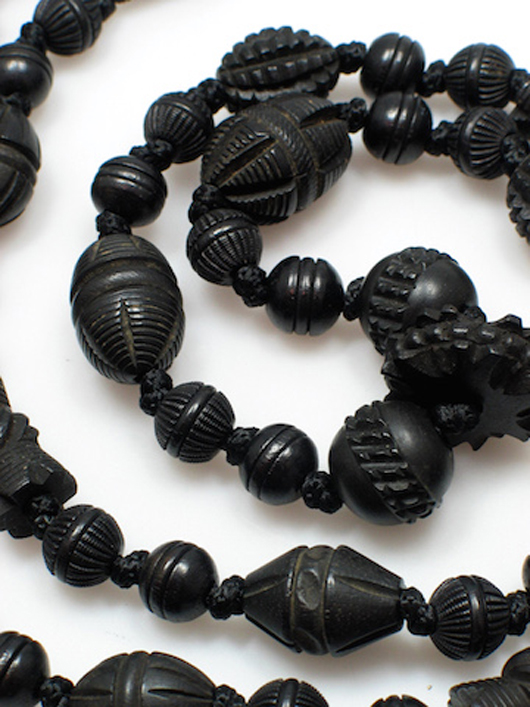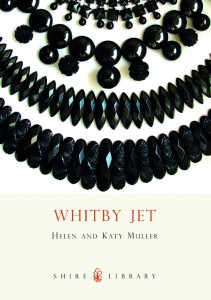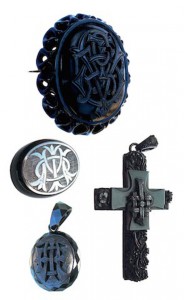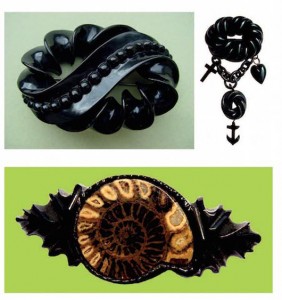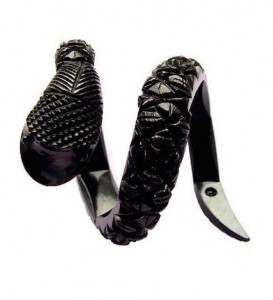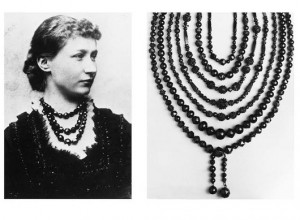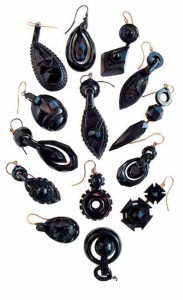LONDON – The woman in the bead shop had never heard of Whitby jet, so we put her right. It was the proper thing to do. According to some observers in the trade, along with amber and coral, jet is “back in the black.”
According to my “business manager” (Mrs. P), beads in general are enjoying something of a renaissance – which is why we were in the bead shop. For the last 20 years or so, she had been hoarding a glass jam jar full of the things that she picked up at a car boot sale. The jar cost 20 pence.
Amazingly, among them were the makings of two complete necklaces, each of the graduated beads hand-cut little marvels of ingenuity and finally, she had got round to having them restrung.
Interestingly, they started life as bits of coal, actually a carboniferous mineral, also know as sea coal, that was once collected from the shoreline to be used as fuel.
Then, in 1800, John Carter and Robert Jefferson discovered it could be cut and polished. Consequently, a thriving cottage industry grew up in the North Yorkshire port but instead of collecting it for the fire, latter-day beachcombers set about fashioning all manner of ornaments from it.
As the industry grew, deposits were mined extensively under difficult and often dangerous conditions from the cliffs for a few short miles along the Yorkshire coast, and carved and modeled into often quite imposing objects. We’ve seen jet altar crosses and even scale models of famous buildings displayed under glass domes.
By far the majority of production was small pieces of jewelry and personal ornaments, however, and by 1872, around 1,500 men, women and children were employed in the production process and the town could boast around 200 shops selling pieces to tourists and sailors. Whitby was also a thriving port – Capt. James Cook served his merchant navy apprenticeship there – and a major whaling center.
Visit Whitby today and shops still have windows offering jet bangles, baubles and beads, all of them antique, of course. The skills needed to carve and polish such intricate and delightful pieces mostly died out years ago.
What helped make Whitby jet jewelry so popular was its use as a symbol of grief. When Prince Albert died in 1861, Queen Victoria made mourning a national pastime. She also decreed that only Whitby jet jewelry could be worn at court during the official period of mourning.
The dull gloss of the mineral suited the heavy black dresses that widows favored, often for months after their loss. Equally heavy brooches, earrings, necklaces, bracelets, rings, lockets and even skilfully carved, massive link chains gave an added somberness to dress in the 1880s.
Whitby jet became so popular that soon entrepreneurial manufacturers began to copy it. Leading the fray were Paris glassmakers who produced deceptively similar so-called French jet. It looks and feels like true jet but you can tell the difference by rubbing it against the enamel of your teeth. If it’s real jet, it’s smooth, while the glass variety grates and scratches.
Harder to tell apart are pieces made from bog oak. This is wood from ancient oak trees that have been preserved over millennia in peat, turning it into an iron-hard material that has been used to make small pieces of furniture, domestic utensils – and jewelry.
The pieces are uncannily similar to jet, naturally enough, for they share the same origin, but jet somehow manages to display a glossier black sheen and can take more intricately cut patterns. Separately, it can be difficult to discern, but put two similar pieces side by side and the differences become more apparent. The bog oak is slightly brownish in color
More obvious is the jewelry made from Ebonite, the brand name for vulcanite, an extremely hard natural rubber developed by the American chemist Charles Goodyear (1800-1860). The material was also used as a substitute for ebony and is collected in its own right.
The Victorian fashion for full mourning lasted only a few years, and that, coupled with the competition from more frivolous and cheaper French jet, resulted in more light-hearted creations from Whitby.
French jet could be cut in more brilliant styles and was better suited to such pieces as facet-cut necklaces and chokers. But fashions change and stunning, often dramatic Whitby jet is now back in favor to set off a modern outfit.
The iconography of Whitby jet patterns and designs is a fascinating study in itself. For example, a design featuring the initials AEI represents amity, eternity and infinity. A single stem rose means love, hope, joy, faith and beauty.
The butterfly represents the soul and a single swallow in flight, the epithet return home safely.
One of the most intricately carved brooches appears to be a jumble of interlocking gothic letters but look carefully and it spells out the name of Whitby jet’s royal patron, Victoria.
Somewhat morbid is the skull, which features in a great deal of morning jewelry, known as “mementi mori.” Pieces bearing the inscription were intended to cause the wearer to reflect on mortality, the vanity of earthly life and the fact that none of us can take any earthly goods with us when we shuffle off, the Latin meaning simply “Remember that we all must to die.”
Don’t let that stop you enjoying Whitby jet while you can, though. The very finest brooches change hands for £500 or more, but more simple and no less charming examples can be had for as little as £10. Look out also for jet hatpins at £40-£60; buttons from £5 and the somewhat scarcer snuffboxes at £200-£300. Top of the shop are mourning necklaces, which can fetches upward of £1,500.
The definitive guide to identifying and collecting Whitby jet can be found in the slim Shire Library guide of the same name by Helen and Katy Muller, priced £5.99, obtainable in High Street bookshops or online at shirebooks.co.uk.



